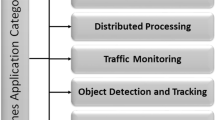Abstract
The use of a localization system is necessary in Wireless Sensor Networks (WSN) either for communication protocols (geographic routing) or for various applications (person tracking, battlefield tele-monitoring, enemy detection, etc.). The objective of a localization method in such environment is to find the locality (or position) of all sensors deployed randomly in a multidimensional field in order to accomplish a specific task. We specify in this paper an improved localization method in WSNs called FOA-L (Fruit Fly Optimization Algorithm for node’s Localization). The proposed method applies the Fruit fly Optimization Algorithm (FOA) to minimize the error between estimated and real locations of the unknown sensors. In the proposed localization scheme, we initialize a group of flies in the search area and they are given a random value of direction and distance. Then, we find out the flies with the highest smell value using fitness in order to estimate the location of the target node. Simulation results concerning performance evaluation show that the proposed technique FOA-L has the better localization accuracy than the well-known localization algorithms such as Particle Swarm Optimization and Chicken Swarm Optimization as well as a faster computation time, which contributes in reducing the cost of the sensor’s localization.








Similar content being viewed by others
REFERENCES
Paul, A.K. and Sato, T., Localization in wireless sensor networks: A survey on algorithms, measurement techniques, applications and challenges, J. Sensor Actuator Networks, 2017, vol. 6, no. 4, p. 24.
Jiandong Yao, Xiaoyong Yan, and Rulin Dou, An anisotropic-tolerant and error control localization algorithm in wireless sensor network, Autom. Control Comput. Sci., 2017, vol. 51, no. 6, pp. 442–452.
Hofmann-Wellenhof, B., Lichteneeger, H., and Collins, J., Global Positioning System: Theory and Practice, New York: Springer, 2001.
Vossiek, M., et al., Wireless local positioning, IEEE Microwave Mag., 2003, vol. 4, no. 4, pp. 77–86.
Yu, K. and Oppermann, I., Performance of UWB position estimation based on time-of-arrival measurements, 2004 International Workshop on Ultra Wideband Systems Joint with Conference on Ultra Wideband Systems and Technologies. Joint UWBST & IWUWBS 2004, 2004, pp. 400–404.
Niculescu, D. and Nath, B., Ad-hoc positioning system (APS) using AOA, IEEE INFOCOM 2003. Twenty-Second Annual Joint Conference of the IEEE Computer and Communications Societies, 2003, vol. 3, pp. 1734–1743.
Zhong, J.W.W.L., Study on the application of DV-Hop localization algorithms to random sensor networks, J. Electron. Inf. Technol., 2008, vol. 4, no. 51.
Niculescu, D. and Nath, B., DV based positioning in ad hoc networks, Telecommun. Syst., 2003, vol. 22, nos. 1–4, pp. 267–280.
Cho, H.H., Lee, R.H., and Park, J.G., Adaptive parameter estimation method for wireless localization using RSSI measurements, J. Electr. Eng. Technol., 2011, vol. 6, no. 6, pp. 883–887.
Ji, X. and Zha, H., Sensor positioning in wireless ad-hoc sensor networks using multidimensional scaling, INFOCOM 2004. Twenty-third Annual Joint Conference of the IEEE Computer and Communications Societies, 2004, vol. 4, pp. 2652–2661.
Li, L. and Kunz, T., Localization applying an efficient neural network mapping, Proceedings of the 1st International Conference on Autonomic Computing and Communication Systems, 2007.
Fonseca, C.M. and Fleming, P.J., Genetic algorithms for multi-objective optimization: Formulation discussion and generalization, Proceedings of the 5th International Conference on Genetic Algorithms, 1993, pp. 416–423.
Hofmeyr, S.A. and Forrest, S., Architecture for an artificial immune system, Evol. Comput., 2000, vol. 8, no. 4, pp. 443–473.
Dorigo, M. and Di Caro, G., Ant colony optimization: A new meta-heuristic, Proceedings of the 1999 Congress on Evolutionary Computation-CEC99, 1999, vol. 2, pp. 1470–1477.
Yang, X.S., Firefly algorithms for multimodal optimization, in International Symposium on Stochastic Algorithms, Springer, Berlin, Heidelberg, 2009, pp. 169–178.
Al Shayokh, Md. and Soo Young Shin, Bio inspired distributed WSN localization based on chicken swarm optimization, Wireless Pers. Commun., 2017, vol. 97, pp. 5691–5706.
Pan, W.T., A new fruit fly optimization algorithm: Taking the financial distress model as an example, Knowl.-Based Syst., 2012, vol. 26, pp. 69–74.
Kannan, A.A., Mao, G., and Vucetic, B., Simulated annealing based wireless sensor network localization, 2006 IEEE 63rd Vehicular Technology Conference, 2006, vol. 1, no. 2, pp. 15–22.
Biswas, P. and Ye, Y., Semidefinite programming for ad hoc wireless sensor network localization, Proceedings of the 3rd International Symposium on Information Processing in Sensor Networks, 2004, pp. 46–54.
Gopakumar, A. and Jacob, L., Localization in wireless sensor networks using particle swarm optimization, 2008 IET International Conference on Wireless, Mobile and Multimedia Networks, 2008.
Nan, G.F., Li, M.Q., and Li, J., Estimation of node localization with a real-coded genetic algorithm in WSNs, 2007 International Conference on Machine Learning and Cybernetics, 2007, vol. 2, pp. 873–878.
Cao, S., Wang, J., and Gu, X., A wireless sensor network location algorithm based on firefly algorithm, in AsiaSim 2012, Springer, Berlin, Heidelberg, 2012, pp. 18–26.
Goyal, S. and Patterh, M.S., Wireless sensor network localization based on cuckoo search algorithm, Wireless Pers. Commun., 2014, vol. 79, no. 1, pp. 223–234.
Sivakumar, S. and Venkatesan, R., Error minimization in localization of wireless sensor networks using ant colony optimization, Int. J. Comput. Appl., 2016, vol. 145, no. 8, pp. 15–21.
Moussa, A. and El-Sheimy, N., Localization of wireless sensor network using Bees Optimization Algorithm, The 10th IEEE International Symposium on Signal Processing and Information Technology, Luxor, 2010, pp. 478–481.
Author information
Authors and Affiliations
Corresponding author
Ethics declarations
The authors declare no conflict of interest.
About this article
Cite this article
Rabhi, S., Semchedine, F. & Mbarek, N. An Improved Method for Distributed Localization in WSNs Based on Fruit Fly Optimization Algorithm. Aut. Control Comp. Sci. 55, 287–297 (2021). https://doi.org/10.3103/S0146411621030081
Received:
Revised:
Accepted:
Published:
Issue Date:
DOI: https://doi.org/10.3103/S0146411621030081




